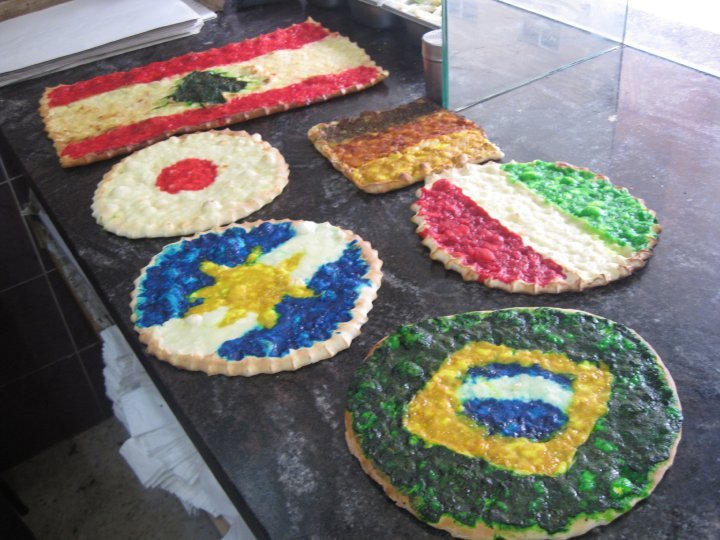My cousin took the following photo at a local bakery in Dubai. Like the rest of the World Dubai appears to be gripped by World Cup fever. So much so that the bakery where this photo was taken has transformed a traditional Levantine staple, the mana2eesh (منائيش) seen in this photo, into World Cup colours and flavors.
Considering this is traditional Lebanese cuisine, naturally, even if Lebanon is not competing in the World Cup in South Africa, a pie resembling our flag was still made.

Mana2eesh, or man2ooshe (منؤشة) in singular, is a traditional oven-baked flour pie that comes with a variety of toppings. It is enjoyed throughout the Middle East where it is usually eaten for breakfast. The idea is similar to pizza but the toppings are very different. It usually comes in many different flavors and toppings (none similar to what is seen in the above photo, however) including za3tar (زعتر), which is a mixture of dried thyme mixed with sesame seeds, sumac (السماق), and olive oil; halloom (حلوم), which is white cheese; khodra (الخضار), which is diced vegetables, usually onions, tomatoes, and parsley mixed with lemon juice and olive oil; kishek (كشك), which is powder made of crushed wheat, onions, and dried goat cheese (mostly in Lebanon); and makhloota (مخلوطة), which is any mixture of the available toppings, more often than not za3tar and khodra, or za3tar and halloom.
If you are wondering where the name منائيش comes from, well, the root word is منقوش which means engraved or incised. This is because when making them, we usually press the dough with our fingers to create small depressions in it’s surface. This helps the pie cook evenly and prevents it from inflating entirely like a loaf of bread. When it’s fully cooked, the surface of the dough will be ridged. In addition, we also add ridges in various patterns to the edge of the dough to prevent the toppings from leaking to the side. These ridges could be considered نقش.
Finally, if you are wondering why the noun uses an ء while the root verb uses a ق , well, it’s because the names are written in the Lebanese dialect, and we happen to transform the ق to an ء in our dialect.





